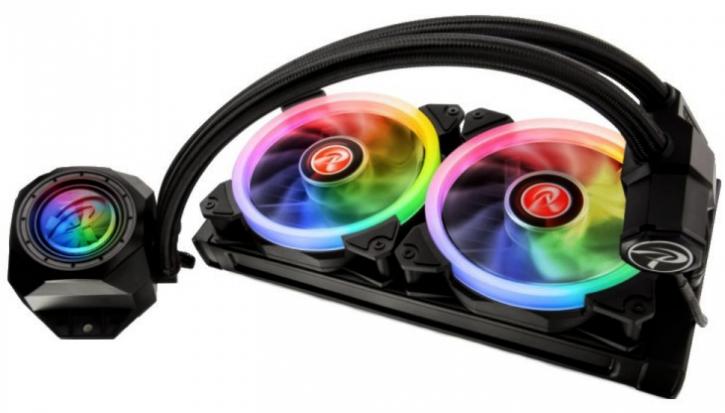Final words and conclusion
Final thoughts.
I like what Raijintek have done with the Orcus 240. Ultimately, the Orcus is an AIO cooler. That is all it is, and much like other coolers before it, it doesn't do anything especially revolutionary or outlandish to really make it stand out from the crowd. That said, nor has practically any other AIO I can think of that has been released in a fairly long while. They all follow a standard formula, and I would argue that it's not only a formula that clearly works, but is also relatively hard to break away from. Asetek pump, hoses, radiator, fans. Add some RGB, maybe a hub, and that's your new product. Practically all advancement of AIOs in the last few years has been from a visual standpoint, as we have progressed from drab and unilluminated pumps to full-on light shows.
The Orcus, however, does so many small things very right. Visually, it is very 'out there', with an eye-catching design which whilst unable to match the wow factor of something like NZXT's infinity mirror Kraken series, certainly still 'pops' at you. The illuminated and chunky CPU block with an inbuilt flow meter is really the focal point of this entire unit, with the RGB fans almost serving to illuminate your case further. In fact, I think this is possibly my favorite AIO on the market from a visual standpoint. For all the RGB, it isn't actually gaudy in any way at all. The fans provide a pleasingly subtle glow, even at max brightness, and the lighting on the CPU block is just enough to back illuminate the flow meter, and that is it. I find it curious that I am drawn to this cooler from a visual/design standpoint as much as I am, as it is normally everything I don't want inside my PC. I am a Noctua and closed side panel guy. I only recently got into tempered glass. I am, in essence, the exact opposite of the audience this unit is targeting. And, yet, I cannot help but like it. It also helps that the RGB functionality for those without a capable 4 pin port on their board (aka. me) is still excellent. The remote works very well indeed, and I was simply able to point + shoot at the unit to have the colors change, though I did need to actively point it from side on. The default 'Auto' mode is what you will see in the photos of the unit fully installed, and one can easily change the mode, speed, and LED intensity of the effect at any given time. Top marks here, Raijintek. Well done.
Performance wise, I have to raise a point here which is unfortunate. As I predicted, it slightly lost out to the similarly priced Fractal Design S24, whilst also being a touch louder. Perhaps that was the price we paid for the spec discrepancy in the fans, though it ended up mattering a lot less than I had anticipated. All in all, a loss of about 3C in terms of load temps is a bit disappointing, but the noise levels when running the 1700X overclocked were nearly comparable, to the tune of about 1.5dBa. Given that I am a performance-focused man, I would have liked a cooler of this price to be able to go toe to toe with the S24, but then again this cooler does have the visual flair that the S24 may lack (for some).
I have to be honest, some factors came together for this review that likely made the performance and acoustics of this cooler a lot worse (or at least were detrimental enough to have it lose out). The first was how warm it is in the UK at the moment. I am under the impression that whilst ambient temps are the same as for other reviews (i.e. 21C), the coolant inside the AIO cannot settle, resulting in the notably higher idle temps that you can see on the graphs. This, naturally, results in higher than I would expect load temps. There is no issue, in my opinion, with what Raijintek provides with this unit. The fans can push a tonne of air, and the pump is happy to buzz away at up to 6,000rpm (as reported in software). The second issue is a two in one, and it comes down to the very simple way Raijintek have opted to do fan control on this unit. Those of us lacking a dedicated CPU_OPT or AIO_PUMP header will be forced to use a regular SYS_FAN header. This wouldn't be so much of an issue in itself, but combined with Ryzen's 20C offset, it made for a bit of an issue with temperature monitoring, with the system continually believing that my CPU was idling way above where it actually was.
Some things I didn't like?
All of that aside, is there anything I really disliked about the unit? Well, possibly. I think the radiator a little shallow, coming it at 27mm, but Raijintek doesn't advertise the rad's FPI anywhere. I still believe this is because it is 'less' than some of its rivals, likely to save on cost. Ultimately, you can supply the best fans possible, but if a radiator is saturated then it is saturated, and it is, therefore, being hurt by a lack of available surface area.
I will take a small moment to mention the fact that the hub needs molex power in 2018. Whilst I don't like this, I also understand that molex is able to provide more power to a greater number of connected devices than SATA power can, and given that it is an 8 port hub, that is entirely fair enough. I get what Raijintek tried to do here, by supplying an 8 port hub they are hoping you buy into their other RGB fans, getting yourself into their ecosystem. Whilst not something I would ever do, it's a consideration and is therefore why I am less annoyed about this molex 'thing' than I normally would be.
The second is a more real-world gripe, and that is the lack of an integrated fan hub, or even the non-inclusion of a PWM fan splitter. Luckily, I had one lying around. This is the one area in which an omission by Raijintek directly affected their own results. Not only does not including a smarter fan control system or even a basic adapter increase complexity and take away control for the end user, but it also had led to the offset issue I encountered. I appreciate that costs need to be kept down, and that the unit cannot be cheap to produce, but if - say - the block didn't illuminate or the ability for motherboard RGB control were taken away, in return for better fan control/connectivity, I would wholeheartedly back it.
Final Words
Much like the lil' Leto I took a look at the other week, I find myself conflicted when looking at the Orcus. It looks utterly, utterly sublime, is exceptionally well built, and is about as easy to install as any other AIO on the market. If it stopped there, I would have no issue recommending the cooler. With that said, I appreciate that circumstances have affected the performance of the cooler today. Namely the much hotter than average temperatures in the UK at the moment, especially where I live in the heart of London. This would have adversely affected coolant temperatures, resulting in worse than expected performance. It ended up mattering a lot less than I thought it would, but perhaps had this review been conducted at a more settled time of the year, things would have been a bit different. Sadly, some elements are beyond my control. That said, the decision to provide extra RGB (and control over it) and looks over connectivity and fan control is one that doesn't sit well with me, and it was a reason why I gravitated so much toward Fractal's S24. If this unit had that or perhaps sacrificed some ports on the included hub to allow for the plugging in of fans, I would be firmly inside the 'like' camp. As it stands, there are some things that it needs to a little better. I still think, however, that it's safe to give this unit a soft recommendation. I've outlined areas in which it does very well, and also highlighted areas where it could certainly stand to improve. I would say if you have a high TDP consumer CPU and a decent mainboard with headers aplenty, then I cannot see anything wrong with giving this the major thumbs up. The whole review process was entirely free of annoyances right up until I had to connect it to my 'lacking in space' MSI B350 board. I cannot and will not comment any further on performance as I think it was unfairly hampered by conditions at the time, as well as the offset problem which perhaps wasn't envisioned as an issue at the time. Sure, I could alter the fan curve, but that is something I do for GPUs. I don't wish to have to do the same for a CPU, as 'Auto' is generally my preferred setting. I trust vendors enough to know that there is likely a reason their PWM curve is the way it is, after all.
- Sign up to receive a notice when we publish a new article
- Or go back to Guru3D's front page



